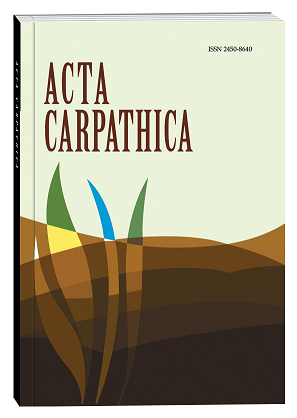INFLUENCE OF MICROFERTILIZER “AVATAR-2 ORGANIC” ON MORPHOBIOLOGY INDICATORS AND PRODUCTIVITY OF CALENDULA OFFICINALIS PLANTS IN THE CONDITIONS OF THE PRECARPATHIAN AREA OF UKRAINE
DOI:
https://doi.org/10.32782/2450-8640.2024.2.8Keywords:
Сalendula officinalis L., microelement preparation, productivity, yield, profitability, economic efficiency.Abstract
The flowers of medicinal marigold (Calendula officinalis L.) are a valuable medicinal raw material, the scarcity of which in both global and domestic markets is steadily increasing due to the increased demands of the pharmaceutical industry for the production of natural medicinal products. Cultivating newly synthesized varieties of C. officinalis in favorable climatic zones of the country, combined with improved technologies, will enable the production of increased volumes of qualitative raw materials from this medicinal plant. The research has shown the growth characteristics of the domestic selection variety C. officinalis Berezotitska Soniachna under the soil and climatic conditions of the Precarpathian area using various norms of the micronutrient preparation (MP) “Avatar 2 Organic” and methods of seed and vegetative plant treatment. We have found that the application of MP for pre-sowing seed treatment of C. officinalis at rates of 50 and 100 ml/ton and double feeding plants during the phenological phases of germination and budding at rates of 50 and 100 ml/ha contributes to the increase in the duration of the growing season, improves the field germination of seeds and the survival rate of plants, as well as contributes to the increase in their morphometric characteristics, productivity, and yield of inflorescences. The exploration has established that the cultivation of C. officinalis in the conditions of the Precarpathian area with the use of micronutrients at pre-sowing treatment rates of 50, 100, and 150 ml/ton of seeds and the treatment of vegetative plants at rates of 50, 100, and 150 ml/ha is economically advantageous. The highest net profit from medicinal plant raw materials of C. officinalis and the level of profitability are observed with the method involving the application of micronutrients in three terms: at the stage of pre-sowing seed treatment (at a preparation rate of 100 ml/ton) and with double foliar feeding during the phases of germination and budding (at a rate of 100 ml/ha). The study has substantiated that the application of MP “Avatar-2 Organic” is one of the reserves for increasing net profit and the level of profitability in the production of dry medicinal raw materials of C. officinalis.
References
1. Barut M., Tansi L.S. Elucidating the flower, seed yield and phytochemical variability of marigold (Calendula officinalis L.) in response to winter sowing at different harvest inter-vals and dates. South African Journal of Botany. 2024. Vol. 166. P. 191–207. https://doi.org/10.1016/j.sajb.2024. 01.043.
2. Abdelwahab S.I., Taha M.M.E., Taha S.M.E., Alsayegh A.A. Fifty-year of global research in Calendula officinalis L. (1971–2021): a bibliometric study. Clinical Complementary Medicine and Pharmacology. 2022. № 2. 100059. https://doi.org/10.1016/j.ccmp.2022.100059.
3. Shahane K., Kshirsagar M., Tambe S., Jain D., Rout S., Ferreira M.K.M., Mali S., Amin P., Srivastav P.P., Cruz J. et al. An Updated review on the multifaceted therapeutic potential of Calendula officinalis L. Pharmaceuticals. 2023. Vol. 16. 611. https://doi.org/10.3390/ ph16040611.
4. Мельничук Р. В., Богуславський Р. Л. Генетичне різноманіття ознакової колекції роду Calendula L. як джерело вихідного матеріалу для селекції. Генетичні ресурси рослин. 2013. № 12. С. 41–52.
5. Лупак О., Антоняк Г., Шпек М. Формування продуктивності Calendula officinalis L. залежно від внесення стимуляторів росту та ґрунтово-кліматичних умов культивування. Вісник Львівського національного аграрного університету: агрономія. Львів :
Львів. нац. аграр. ун-т. 2016. № 20. С. 60–65. URL: http://nbuv.gov.ua/j-pdf/Vlnau_act_2016_20_14.pdf.
6. Batsmanova L., Taran N., Konotop Y., Kalenska S., Novytska N. Use of a colloidal solution of metal and metal oxide-containing nanoparticles as fertilizer for increasing soybean productivity. Journal of Central European Agriculture. 2020. Vol. 21. № 2. Р. 311–319.
URL: https://doi.org/10.5513/JCEA01/21.2.2414.
7. Faraz A., Hayat S. Nanoparticles: biosynthesis, translocation and role in plant metabolism. IET Nanobiotechnol. 2019. Vol. 13 (4). P. 345–352. URL: https://doi.org/10.1049/ietnbt.2018.5251.
8. Хоміна В. Я., Недільська У. І. Урожайність нагідок лікарських залежно від застосування біологічно активних препаратів. Збірник наукових праць Подільського державного аграрно-технічного університету. 2010. Вип. 18. С. 59–62. URL:
http://188.190.33.56:7980/jspui/handle/123456789/ 2325.
9. Клепач Г. М., Лупак О. М., Шпек М. П., Дякунчак М., Ковальчук Г. Я. Вплив передпосівної обробки мікродобривом «Aватар-2 Органік» на лабораторну та польову схожість насіння Calendula officinalis L. Acta Carpathica. 2022. № 1 (37). C. 27–39.
https://doi.org/10.32782/2450-8640.2022.1.2.
10. Дерев’янко С. В., Васильченко А. В., Каплуненко В. Г., Голоко А., Співак М., Харчук М. Перспективи розробки препаратів для сільського господарства на основі наночастинок. Вісник аграрної науки. 2019. № 10. Вип. 799. С. 44–54.
https://doi.org/20.31073/agrovisnyk 201910-07.
11. Тищенко М. В., Мороз О. В., Смірних В. М., Новоселецький І. Г., Кусков О. Г., Філоненко С. В., Ляшенко В. В. Використання мікроелементного препарату «Аватар» за вирощування ячменю ярого в польовій сівозміні. Вісник Полтавської державної
аграрної академії. 2018. № 3. С. 32–38. https://doi.org/10.31210/visnyk2018.03.05.
12. Капітанська О. С., Прядкіна Г. О., Стасик О. О. Вплив обробки рослин комплексом карбоксилатів мікроелементів на фотосинтетичні показники і урожай озимої пшениці. Фізіологія рослин і Генетика. 2017. Т. 49. № 3. С. 248–255. https://doi.org/10.15407/frg2017.03.248.
13. Zhao L., Xing B. Nano-Biotechnology in Agriculture: Use of Nanomaterials to Promote Plant Growth and Stress Tolerance. J Agric Food Chem. 2020. Vol. 68. Iss. 7. P. 1935–1947. https://doi.org/10.1021/acs.jafc.9b 06615.
14. Засіб для передпосівної обробки насіння сільськогосподарських культур: пат. 91892 Україна: a200810241; заявл. 11.08.2008; опубл.: 10.09.2010, Бюл. № 17. 4 с. URL: https://uapatents.com/4-91892-zasib-dlya-peredposivno-obrobki-nasinnya-silskogospodarskikh-kultur.html.
15. Стефанюк В. Й., Балан В. М., Фурса А. В. Продуктивність стевії залежно від застосування мікродобрива «Аватар-2». Біоенергетика. 2020. Вип. 2 (16). С. 27–29. URL: https://doi.org/10.47414/be.2.2020.224998.








